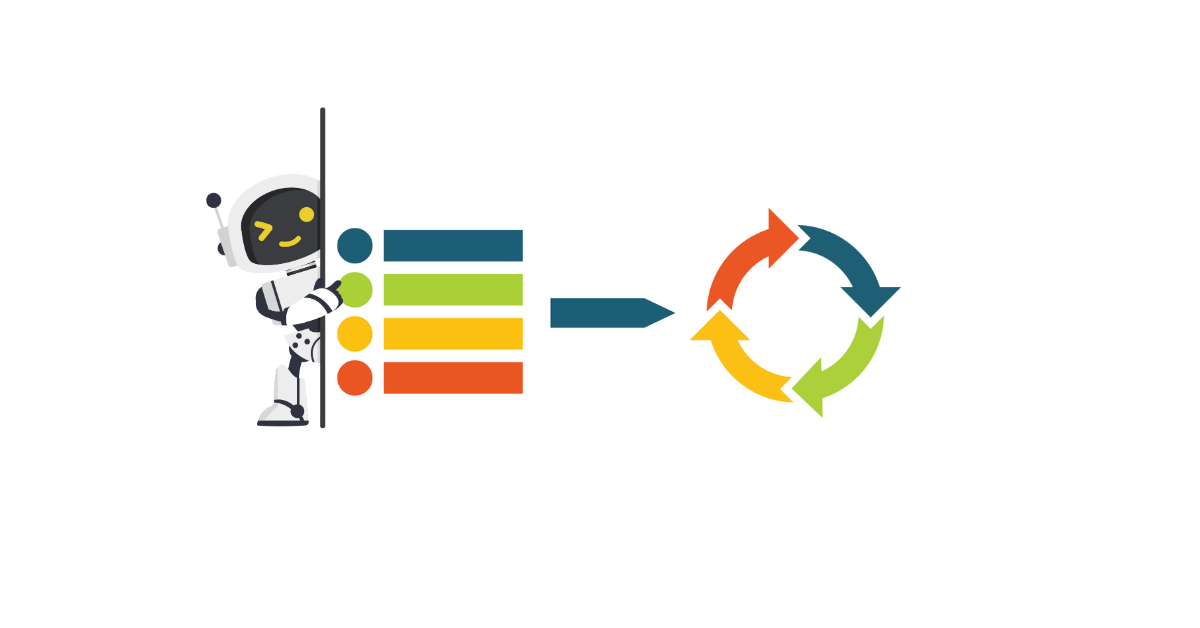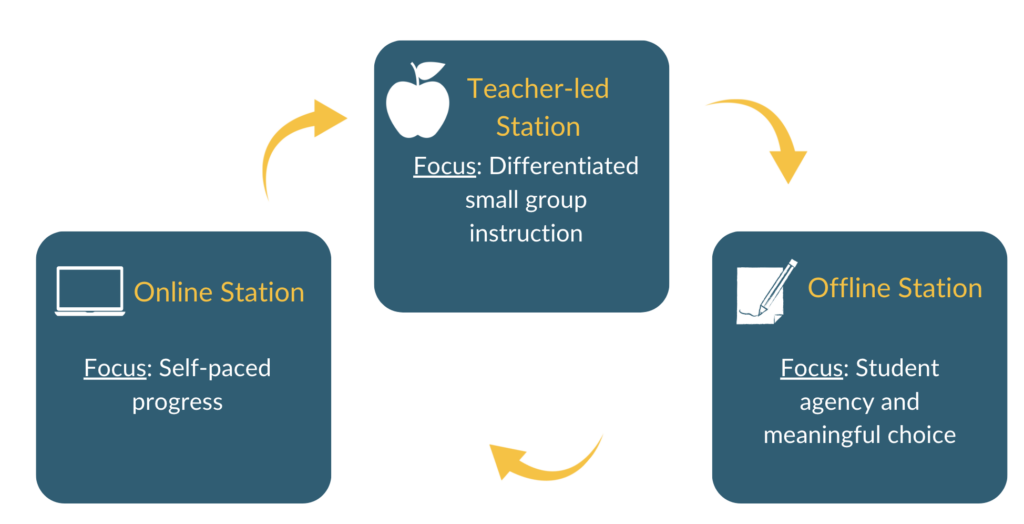In my last blog post titled Part I: Station Rotation Design Tip – Go Horizontal with Your Linear Agenda, I shared a strategy I refer to as “going horizontal” to help secondary teachers shift from traditional whole group, teacher-led lessons to designing with the station rotation model.
As described in my previous post, the station rotation model can help teachers provide students with:
- Increased access to differentiated instruction, models, support, and scaffolds.
- More teacher-student interactions and personalized support (e.g., guided practice, feedback).
- Student-centered learning experiences that encourage critical thinking, communication, collaboration, and creativity.
- Students have more control over the pace of their learning.
- Students have more control over the path of their learning when teachers integrate meaningful choices into the work at the various stations.
- More self-directed learning and opportunities for students to develop their self-management and responsible decision-making skills.
Given the benefits of shifting to small groups, I want to support teachers in using AI-powered education tools to make this work designing station rotation lessons easier to do! AI drastically reduces the time needed to design a differentiated learning experience that gives students more control over the pace and path of their learning to increase engagement and boost learner confidence!
Using AI to Support The Design Process
Let’s focus on a math example since math lessons build on each other sequentially, which can make it challenging for math teachers to shift away from the whole group lesson.
I used MagicSchool.ai to generate a math lesson based on a specific CCSS algebra standard. There are lots of AI-powered education tools, so feel free to use the one that works best for you!
MagicSchool.ai generated the following whole group, teacher-led lesson based on the standard I provided and the note to include a spiral review of a previously covered concept.
Lesson Plan: Creating Equations that Describe Numbers or Relationships
Objective: Students will be able to create equations and inequalities in one variable, including linear, quadratic, and exponential equations, and use them to solve problems.
Assessment: The assessment for this lesson will be a worksheet that includes various scenarios where students need to create equations and inequalities to represent the given situations. They will also be required to solve the equations and inequalities for the unknown variable. The worksheet will assess their ability to apply the concepts taught in the lesson.
Opening: To engage students and capture their interest, start the lesson with a real-world scenario. Present them with a problem such as: “You are going on a road trip and need to calculate the total cost based on the number of miles driven. How can we represent this situation using an equation?”
Introduction to New Material: Explain to students that equations and inequalities are powerful tools for describing numbers and relationships. Emphasize that different types of equations can be used to represent different types of relationships. Provide definitions and examples of linear, quadratic, and exponential equations, as well as absolute value equations. Address the common misconception that equations are only used for solving problems, and emphasize their importance as a way to describe relationships.
Guided Practice: During the guided practice, scaffold the questioning from easy to hard to ensure students grasp the concepts gradually. Provide them with examples of each type of equation and guide them through the process of creating equations for different scenarios. Monitor their performance and address any misconceptions or difficulties they may have during the practice.
Independent Practice: During the independent practice, students will complete an assignment that demonstrates their mastery of creating equations and inequalities. The assignment will include various problem-solving scenarios where they need to create the appropriate equation or inequality and solve for the unknown variable. Set behavioral expectations for focused work time and encourage students to ask questions if they need further clarification.
Closing: For the closing activity, have students share one equation they created during the independent practice and explain the relationship it represents. This will serve as a quick summary of what they have learned and provide an opportunity for peer learning and reinforcement.
Extension Activity: For early finishers, provide an extension activity where they create their scenario and corresponding equation or inequality. Encourage them to be creative and think of real-world applications for their equations.
Reimagining that AI-generated Whole Group Lesson as a Rotation
Next, I turned to ChatGPT to help me take that linear lesson and reimagine it as a station rotation lesson. I provided ChatGPT with the following instructions.
Prompt: Can you transform this linear whole-group, teacher-led math lesson into a station rotation lesson that has a teacher-led station, one online station, and an offline station? How would you suggest reorganizing this to allow the teacher to differentiate the instruction, models, and scaffolds at the teacher-led station? Keep in mind that students will be starting at different stations so they cannot build on one another.
Below are ChatGPT’s suggestions for how this might be reimagined as a station rotation lesson.
Teacher-Led Station:
- Objective: Focus on differentiating instruction, models, and scaffolds based on individual student needs.
- Activities:
- Small Group Instruction: Tailor the lesson to address the specific needs of each group. Start with a brief review of the lesson’s key points, then move into addressing specific questions or confusions.
- Targeted Practice: Provide problem sets that are differentiated based on student ability levels. Scaffold problems for students who need more support and offer more challenging problems for advanced learners.
- Feedback and Guidance: Give immediate feedback and guidance. Use this time to address misconceptions and provide additional explanations.
- Materials: Whiteboard for demonstrations, differentiated problem sets, and manipulatives for visual learners.
Online Station:
- Objective: Reinforce concepts through interactive and engaging online activities.
- Activities:
- Interactive Simulations: Use online tools (like Desmos or Geogebra) for students to experiment with different types of equations.
- Video Lessons: Curate a playlist of short videos explaining linear, quadratic, and exponential equations, and absolute value equations.
- Practice Quizzes: Include online quizzes for immediate feedback.
- Materials: Computers or tablets with internet access, headphones.
Offline Station:
- Objective: Encourage independent practice and application of concepts.
- Activities:
- Worksheet Completion: The worksheet described in your assessment can be used here. It can include scenarios for creating and solving equations and inequalities.
- Peer Collaboration: Encourage students to work in pairs to solve problems and explain their thinking to each other.
- Real-World Applications: Provide scenarios for students to create their own equations and inequalities.
- Materials: Worksheets, pencils, calculators, real-world scenario cards.
Teachers can dig even deeper, working with an AI-powered education tool to flush out individual activities, generate examples and models, and develop scaffolds to support the learning happening at each station in this rotation.
Wrap Up
As educators embark on the journey of redesigning traditional teacher-led lessons into student-centered station rotation lessons, AI is a game-changer. AI-powered education tools are not just innovative; they can revolutionize how we approach lesson design, differentiation, and student agency.
In embracing the capabilities of AI, we are not just adapting to technological trends; we are leveraging technology to create more inclusive, engaging, and equitable learning experiences. AI in education represents a significant step forward in designing and facilitating learning so that every student has the opportunity to succeed and thrive.
Want To Learn More About the Station Rotation?
📚 Explore my collection of blogs on the station rotation model.
💻 Check out my asynchronous Station Rotation Mini-course, complete with video instruction, application activities, and tons of resources.
🚀 Join the spring cohort of my Supercharge Your Classroom with UDL and Blended Learning Course!






No responses yet